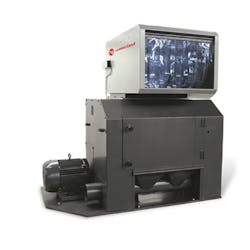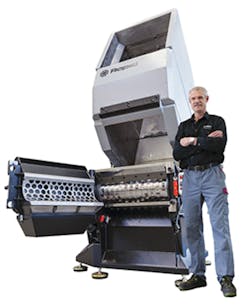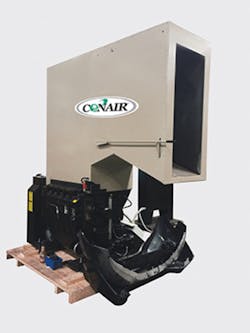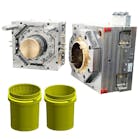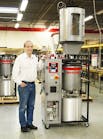Special Report: Shredder, granulator makers seek safer options
Equipment manufacturers are looking at ways to make shredders and granulators safer for operators.
While the machines are essential for recycling plastics, they can be dangerous due to sharp rotating knives that, in some cases, can chew up material as large as car bumpers.
While safeguards long have been incorporated into these machines, several manufacturers say they recently have introduced new technology to further improve safety or will be doing so soon.
ACS Group
ACS Group, headquartered in New Berlin, Wis., manufactures shredders and granulators under the Cumberland, Sterling and AEC brands. The company is phasing in three safety-related improvements, said Tyler Check, size reduction product manager for ACS Group.
First, the company will install zero-speed solenoids that deny access to the chamber until a shredder or granulator is fully stopped.
"Some people have done that, but it's not a standard that is used a lot," Check said. "A lot of people just say, 'Don't access the chamber for 3 minutes after you shut it off,' so there is a risk of getting cut after the machine is shut off."
A positive locking solenoid will prevent the opening of access points.
The second improvement is installing dual- channel redundant safety interlocks so even if one channel fails, a person can't access the machine while it is running. "Traditionally, there are a few areas [where] you can access the cutting chamber, usually through the front door or the hopper area," Check said. "All those access areas have interlocks on them, so that interlock tells the control if it is open and then the machine can't turn on. Over time, the interlocks get beat up or people try to tamper with them to lock them in place so they are always active."
However, with a dual-channel redundant safety interlock, there are two contacts on each of the interlocks and they are redundant so if one contact fails, the second would still work.
"It's like getting two locks on a door," Check said.
The third improvement is that the electrical panel behind the PLC is going to become low voltage. The panel will be 24 volts instead of the traditional 110 or 460 volts, Check said.
"People need to access the actual control enclosure behind [the PLC] for a variety of reasons — to adjust settings, for troubleshooting, if the machine doesn't turn on, or maybe a wire is loose," Check said.
The lower voltage minimizes or even eliminates the risk of electrocution for maintenance workers, who might also need to wear less protective equipment when working on low-voltage panels. However, ACS encourages the use of appropriate levels of safety equipment for every job near electricity, company officials said.
ACS will incorporate the new safety features into all future models. In addition, it plans to phase in the improvements to its existing product line. "Within the next two years, all of our equipment will have these three features," Check said.
The company is continuously making electrical and mechanical improvements to further enhance safety, he added.
Rapid Granulator
Rapid Granulator AB — which is based in Bredaryd, Sweden, but has offices in Leetsdale, Pa. — introduced its Raptor Shredder at the K show in October, making it the newest model in its line of shredders.
The Raptor has several unusual safety features, said Jim Hoffman, VP for sales and marketing.
The shredder's "open-hearted design" features a door on the front of the unit that allows access without an operator having to reach down inside the machine, Hoffman said.
"With our open-hearted design, the way the front door opens, they've got complete access from the front and they don't have to lean over the rotor," he said. "They can work on it from the front, safely."
A second safety feature is a rotor motion sensor that ensures the rotor has come to a complete stop and then uses a delay timer before allowing access to the cutting chamber.
As an additional precaution, a removable handle or tool allows the shredder rotor to be safely rotated through the gearbox externally, without the need for touching the rotor. This allows the operator to easily and safely rotate the rotor without disconnecting the gearbox or coming into direct contact with the rotor. A spring-loaded insert prevents the rotation tool from accidentally being left in the rotation socket after repairs are completed.
The unit is designed so that heavier parts, including knives and screens, are made in multiple pieces for easier and safer handling, Hoffman said.
While some of these safety features had been incorporated into the company's existing Rapid Series 300-600 granulators, a unique feature for the Raptor is a PLC that has a tablet interface to allow an operator to wirelessly program and monitor the operation of the machine. The remote PLC access allows operators to easily and safely adjust machines.
"You don't have to open the electrical panels in order to access the controls," Hoffman said. "You can do it in a safe way. You can change the setup. You are able to do it remotely, wirelessly."
Monitoring the condition of the shredder and diagnosing error codes without needing access to the main electrical enclosure limits exposure to high-voltage electrical panels and creates a safer working environment, he said.
Conair Group
To meet the needs of one of its customers, Conair Group, Cranberry Township, Pa., designed a special hopper to ensure safe size reduction of scrap bumpers.
A company producing large automotive parts asked Conair to recommend a central granulator for handling scrap car bumpers — large and bulky items that normally would require a conveyor and a big granulator with an infeed opening about 8 feet off the plant floor. However, the company's plant lacked sufficient space for the conveyor.
A loading platform could have been installed, but the company was concerned about the safety of its employees, who would need to handle large, heavy parts well above floor level.
Conair officials came up with an alternative: using a smaller granulator with a specially designed hopper that could be fed safely from floor level. In 2015, the company installed a Conair Model CW granulator with a custom hopper that allows bumpers to be fed safely from floor level by hand rather than conveyor.
The parts are placed into the feed opening and the operator moves a lever on the side of the hopper to tilt the bumper up so it slides into the cutting chamber for clean, efficient size reduction, according to the company.
The granulator has a footprint just 68 by 75 inches — about half the size of a Conair CKW granulator, the model that otherwise would have been used for the job.
Meanwhile, all of Conair's granulators conform to safety standards issued by the Plastics Industry Association and other organizations, including the European Community, said David Miller, general manager for size reduction.
"The SPI [Plastics Industry Association] standards for granulators date back to the mid-1980s and soon will be updated to require the use of newer safety technologies," he said. "Also, for the first time, standards covering shredders are expected to be added. Conair has been and will continue to be actively involved on the committee working on the update."
Bruce Geiselman, correspondent
Contact:
ACS Group, 262-641-8600, www.acscorporate.com
Conair Group, 724-584-5500, www.conairgroup.com
Rapid Granulator, 724-584-5220, www.rapidgranulator.com
Bruce Geiselman | Senior Staff Reporter
Senior Staff Reporter Bruce Geiselman covers extrusion, blow molding, additive manufacturing, automation and end markets including automotive and packaging. He also writes features, including In Other Words and Problem Solved, for Plastics Machinery & Manufacturing, Plastics Recycling and The Journal of Blow Molding. He has extensive experience in daily and magazine journalism.
Plastics Hall of Fame seeks nominees
Amcor, Berry Global will merge

